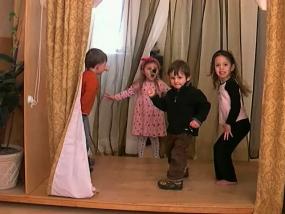Three Little Pigs

Four children enjoy their first experience working to adapt a familiar storybook, “Three Little Pigs”, to the theatre stage. The off camera teacher takes on the supporting role of narrator. As you watch this video, study what strategies the narrator uses to facilitate the children’s success. Notice that she adapts to the children’s spontaneous changes in order to sustain the play and facilitate each child’s participation. For example, when the children are cued to come onstage by the introduction of their characters, the third little pig remains off stage. While continuing to use the voice quality of a narrator, the teacher offers the third child an additional clue. She says, “And where’s the other pig?” The third child remains offstage so the teacher uses her role as narrator to modify the story script by saying, “And a hiding pig” (00:17). By making this change, the teacher enables the performance to continue and creates a way to include the off stage child in the story plot. When the third pig emerges onstage (00:22), the narrator both welcomes the child and establishes his character in the play by saying, “There’s the other brother!” Moments later, when the narrator asks the third pig, “What are you making yours (your house) out of little brother”, the child steps outside of the pretend story script. He shakes his head and says, “I’m a big person” (00:38). The narrator incorporates his revision by saying, “Excuse me, what are you making yours out of big person brother?” (00:42).
Think about ways that learning to perform “Three Little Pigs” on stage may help the children become more knowledgeable about story structure in general. Notice how each series of events is marked by the children’s transitions on and off stage. Observe that the teacher facilitates these transitions by using her narrator role to give the children cues about what comes next in the story sequence. For example, when it is time for the Big Person Brother (little brother pig) to build his house and the Sister Pig lingers onstage, the narrator says, “the sister went off” (01:05). Later, the narrator cues the Big Person Pig (little brother pig) to transition off stage by saying, “And so the big person big ran, and ran, and ran, all the way to the house of his sister” (02:00).
Big Brother Pig demonstrates knowledge of another’s perspective when little brother pig remains off stage and the narrator asks, “And where’s the other pig?” Big Brother Pig replies by saying, “He’s hiding so that you don’t see him” (00:14). The child (Big Brother Pig) understands that a member of the audience (off camera teacher) cannot observe a character when he or she is standing behind the stage. Also notice that some of the children use props and gestures to enhance their characters. For example, the Big Brother Pig and the Wolf both wear noses to symbolize their animal roles. In addition, the Wolf stomps her feat as she approaches and speaks with exaggerated emphasis as she says, “Little Pigs, Little Pigs, let me in!” (02:30). The teacher works to further develop the children’s sense of audience when she invites the children to extend their symbolizations by inventing gestures that represent their character’s actions. For example, she asks Big Person Brother (little brother pig), “What kind of tools did you use to build your house? Could you show me with your body?”
Length of stand-alone master video clip: 4 minutes 29 seconds
Highlight the text above and paste to a document to have your own copy.
Keywords: Threes, Body, Children-Teacher, Teaching, Literacy, Sequence, Symbolization
